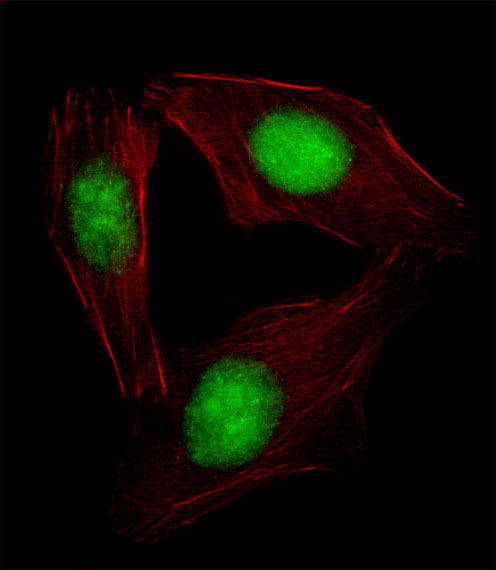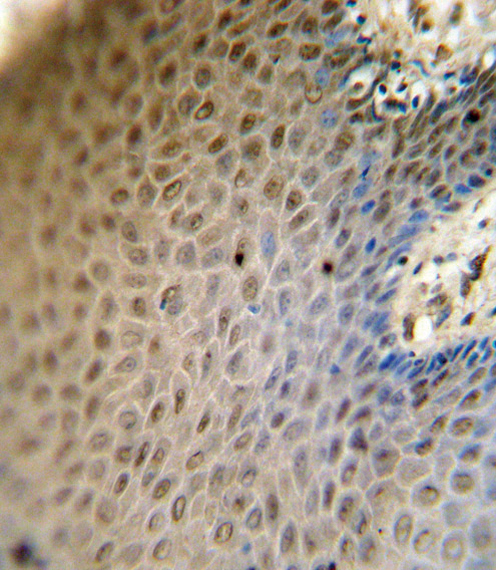SREBF2 Antibody (Center)
Affinity Purified Rabbit Polyclonal Antibody (Pab)
- SPECIFICATION
- CITATIONS
- PROTOCOLS
- BACKGROUND

Application
| WB, IF, IHC-P, E |
|---|---|
| Primary Accession | Q12772 |
| Other Accession | NP_004590.2 |
| Reactivity | Human |
| Host | Rabbit |
| Clonality | Polyclonal |
| Isotype | Rabbit IgG |
| Calculated MW | 123688 Da |
| Antigen Region | 399-427 aa |
| Gene ID | 6721 |
|---|---|
| Other Names | Sterol regulatory element-binding protein 2, SREBP-2, Class D basic helix-loop-helix protein 2, bHLHd2, Sterol regulatory element-binding transcription factor 2, Processed sterol regulatory element-binding protein 2, SREBF2, BHLHD2, SREBP2 |
| Target/Specificity | This SREBF2 antibody is generated from rabbits immunized with a KLH conjugated synthetic peptide between 399-427 amino acids from the Central region of human SREBF2. |
| Dilution | WB~~1:1000 IF~~1:10~50 IHC-P~~1:10~50 E~~Use at an assay dependent concentration. |
| Format | Purified polyclonal antibody supplied in PBS with 0.09% (W/V) sodium azide. This antibody is purified through a protein A column, followed by peptide affinity purification. |
| Storage | Maintain refrigerated at 2-8°C for up to 2 weeks. For long term storage store at -20°C in small aliquots to prevent freeze-thaw cycles. |
| Precautions | SREBF2 Antibody (Center) is for research use only and not for use in diagnostic or therapeutic procedures. |
| Name | SREBF2 {ECO:0000303|PubMed:32322062, ECO:0000312|HGNC:HGNC:11290} |
|---|---|
| Function | [Sterol regulatory element-binding protein 2]: Precursor of the transcription factor form (Processed sterol regulatory element- binding protein 2), which is embedded in the endoplasmic reticulum membrane (PubMed:32322062). Low sterol concentrations promote processing of this form, releasing the transcription factor form that translocates into the nucleus and activates transcription of genes involved in cholesterol biosynthesis (PubMed:32322062). |
| Cellular Location | [Sterol regulatory element-binding protein 2]: Endoplasmic reticulum membrane; Multi- pass membrane protein. Golgi apparatus membrane; Multi-pass membrane protein. Cytoplasmic vesicle, COPII-coated vesicle membrane; Multi-pass membrane protein. Note=At high sterol concentrations, the SCAP- SREBP is retained in the endoplasmic reticulum (PubMed:32322062). Low sterol concentrations promote recruitment into COPII-coated vesicles and transport of the SCAP-SREBP to the Golgi, where it is processed (PubMed:32322062). |
| Tissue Location | Ubiquitously expressed in adult and fetal tissues. |

Thousands of laboratories across the world have published research that depended on the performance of antibodies from Abcepta to advance their research. Check out links to articles that cite our products in major peer-reviewed journals, organized by research category.
info@abcepta.com, and receive a free "I Love Antibodies" mug.
Provided below are standard protocols that you may find useful for product applications.
Background
SREBPs, including SREBP-1a, SREBP-1c, and SREBP-2, constitute a family of basic helix-loop-helix (bHLH) transcription factors that play a critical role in lipid homeostasis by regulating genes involved in cholesterol and fatty acid metabolism. Each SREBP consists of three domains, including an amino-terminal transcription factor domain of ~480 amino acids, a middle hydrophobic region of ~80 amino acids containing two hydrophobic transmembrane segments, and a carboxy-terminal regulatory domain of ~590 amino acids. SREBP-2 regulates cholesterol synthesis by activating the transcription of genes for HMG-CoA reductase and other enzymes of the cholesterol synthetic pathway. SREBP-2 is ubiquitously detected in various tissues. Under basal conditions SREBP is bound to ER membranes as a glycosylated precursor protein. Upon cholesterol depletion, the protein is cleaved to its active forms (about 50-68 kDa) and translocated into the nucleus to stimulate transcription of genes involved in the uptake and synthesis of cholesterol.
References
Gerin, I., et al. J. Biol. Chem. 285(44):33652-33661(2010) Bailey, S.D., et al. Diabetes Care 33(10):2250-2253(2010) Marquart, T.J., et al. Proc. Natl. Acad. Sci. U.S.A. 107(27):12228-12232(2010) Najafi-Shoushtari, S.H., et al. Science 328(5985):1566-1569(2010) Pramfalk, C., et al. J. Lipid Res. 51(6):1354-1362(2010)
If you have used an Abcepta product and would like to share how it has performed, please click on the "Submit Review" button and provide the requested information. Our staff will examine and post your review and contact you if needed.
If you have any additional inquiries please email technical services at tech@abcepta.com.













 Foundational characteristics of cancer include proliferation, angiogenesis, migration, evasion of apoptosis, and cellular immortality. Find key markers for these cellular processes and antibodies to detect them.
Foundational characteristics of cancer include proliferation, angiogenesis, migration, evasion of apoptosis, and cellular immortality. Find key markers for these cellular processes and antibodies to detect them. The SUMOplot™ Analysis Program predicts and scores sumoylation sites in your protein. SUMOylation is a post-translational modification involved in various cellular processes, such as nuclear-cytosolic transport, transcriptional regulation, apoptosis, protein stability, response to stress, and progression through the cell cycle.
The SUMOplot™ Analysis Program predicts and scores sumoylation sites in your protein. SUMOylation is a post-translational modification involved in various cellular processes, such as nuclear-cytosolic transport, transcriptional regulation, apoptosis, protein stability, response to stress, and progression through the cell cycle. The Autophagy Receptor Motif Plotter predicts and scores autophagy receptor binding sites in your protein. Identifying proteins connected to this pathway is critical to understanding the role of autophagy in physiological as well as pathological processes such as development, differentiation, neurodegenerative diseases, stress, infection, and cancer.
The Autophagy Receptor Motif Plotter predicts and scores autophagy receptor binding sites in your protein. Identifying proteins connected to this pathway is critical to understanding the role of autophagy in physiological as well as pathological processes such as development, differentiation, neurodegenerative diseases, stress, infection, and cancer.




